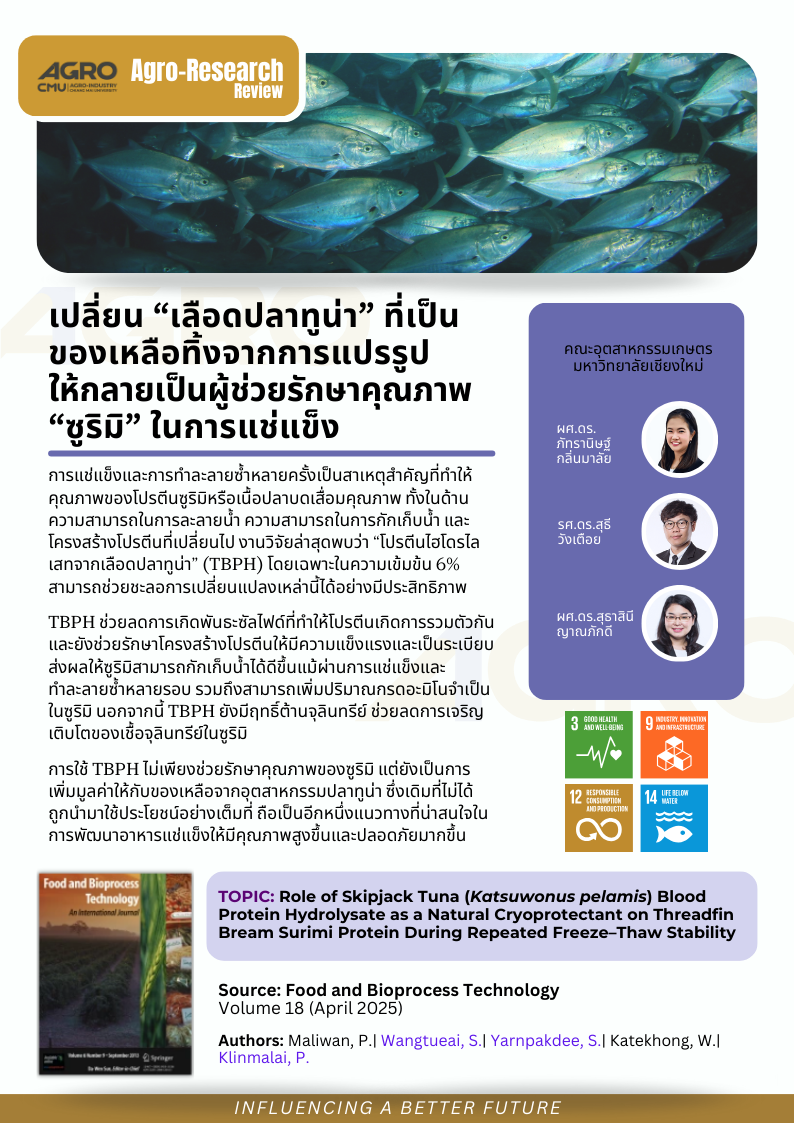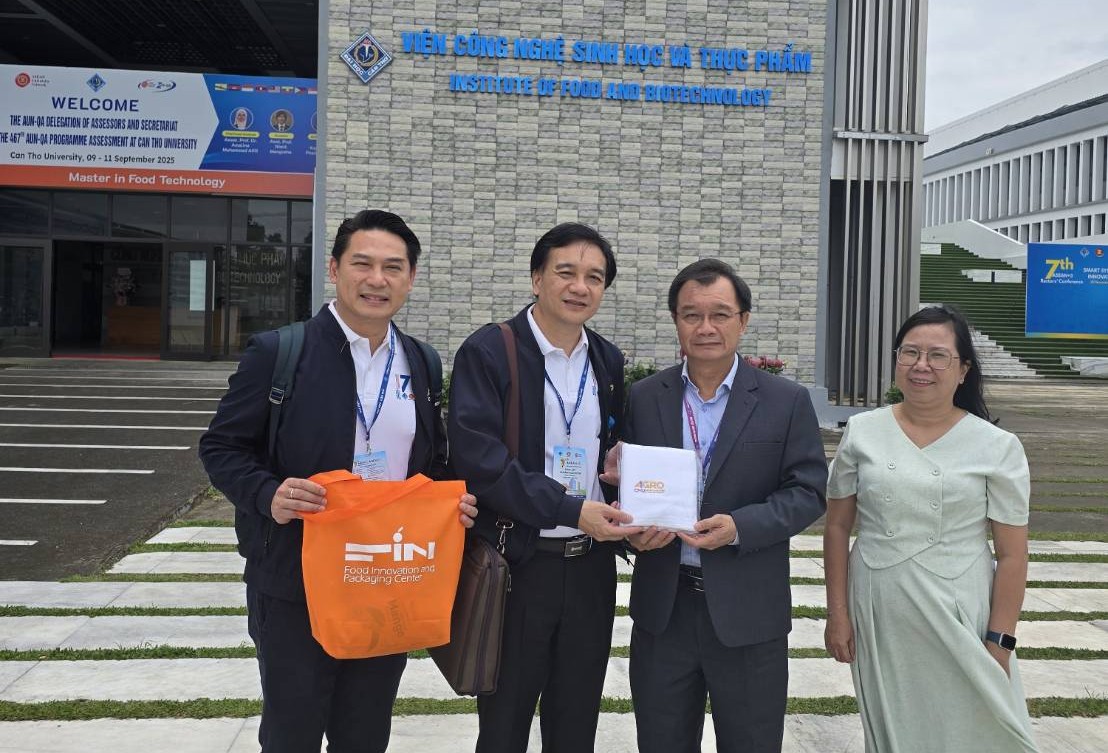
เปลี่ยน “เลือดปลาทูน่า” ที่เป็นของเหลือทิ้งจากการแปรรูปให้กลายเป็นผู้ช่วยรักษาคุณภาพ “ซูริมิ” ในการแช่แข็ง
การแช่แข็งและการทำละลายซ้ำหลายครั้งเป็นสาเหตุสำคัญที่ทำให้คุณภาพของโปรตีนซูริมิหรือเนื้อปลาบดเสื่อมคุณภาพ ทั้งในด้านความสามารถในการละลายน้ำ ความสามารถในการกักเก็บน้ำ และโครงสร้างโปรตีนที่เปลี่ยนไป งานวิจัยล่าสุดพบว่า “โปรตีนไฮโดรไลเสทจากเลือดปลาทูน่า” (TBPH) โดยเฉพาะในความเข้มข้น 6% สามารถช่วยชะลอการเปลี่ยนแปลงเหล่านี้ได้อย่างมีประสิทธิภาพ
TBPH ช่วยลดการเกิดพันธะซัลไฟด์ที่ทำให้โปรตีนเกิดการรวมตัวกัน และยังช่วยรักษาโครงสร้างโปรตีนให้มีความแข็งแรงและเป็นระเบียบ ส่งผลให้ซูริมิสามารถกักเก็บน้ำได้ดีขึ้นแม้ผ่านการแช่แข็งและทำละลายซ้ำหลายรอบ รวมถึงสามารถเพิ่มปริมาณกรดอะมิโนจำเป็นในซูริมิ นอกจากนี้ TBPH ยังมีฤทธิ์ต้านจุลินทรีย์ ช่วยลดการเจริญเติบโตของเชื้อจุลินทรีย์ในซูริมิ
การใช้ TBPH ไม่เพียงช่วยรักษาคุณภาพของซูริมิ แต่ยังเป็นการเพิ่มมูลค่าให้กับของเหลือจากอุตสาหกรรมปลาทูน่า ซึ่งเดิมที่ไม่ได้ถูกนำมาใช้ประโยชน์อย่างเต็มที่ ถือเป็นอีกหนึ่งแนวทางที่น่าสนใจในการพัฒนาอาหารแช่แข็งให้มีคุณภาพสูงขึ้นและปลอดภัยมากขึ้น
Repeated freezing and thawing is a major factor that deteriorates the quality of surimi, a processed fish paste widely used in seafood products. These cycles lead to protein denaturation, reduced solubility, loss of water-holding capacity, and structural changes in the protein network. Recent findings show that tuna blood protein hydrolysate (TBPH), especially at a 6% concentration, can effectively slow down these changes.
TBPH helps reduce the formation of disulfide bonds that cause protein hardening and maintains a more organized protein structure. This results in better water retention even after multiple freeze–thaw cycles. Additionally, TBPH exhibits antimicrobial properties, helping to suppress microbial growth in surimi products.
Using TBPH not only preserves the functional qualities of surimi but also adds value to tuna processing by-products that are often discarded. This approach offers a promising alternative to conventional cryoprotectants like sugar and phosphate, which may affect taste or raise health concerns. TBPH provides a natural solution to improve the quality and safety of frozen seafood products while supporting sustainable resource utilization.
Topic: Role of Skipjack Tuna (Katsuwonus pelamis) Blood Protein Hydrolysate as a Natural Cryoprotectant on Threadfin Bream Surimi Protein During Repeated Freeze–Thaw Stability Authors: Maliwan, P.| Wangtueai, S.| Yarnpakdee, S.| Katekhong, W.| Klinmalai, P.
Abstract:
Keywords: Cryoprotectant; Fish blood protein hydrolysate; Freeze-thaw cycles; Myofibrillar protein; Protein secondary structure
This study investigated the effects of various cryoprotectants including sucrose (8%, w/w), sucrose: sorbitol (1:1) for 8%, tuna blood protein hydrolysates (TBPH) at 6 and 8% on protein structural changes in threadfin bream surimi after repeated four freeze-thaw cycles. Changes in salt solubility, total sulfhydryl content, disulfide bond content, and protein secondary structure were used to assess structural alterations of proteins in surimi with and without various cryoprotectant. Across all samples, protein solubility and total sulfhydryl content decreased with an increasing number of freeze-thaw cycles, while disulfide bond content increased. Notably, threadfin bream natural actomyosin (NAM) without cryoprotectants showed a significant decrease in protein solubility, indicating protein denaturation due to frozen storage and freeze-thaw processes. Interestingly, 6% TBPH was most effective at slowing the reduction in surimi protein solubility. Furthermore, NAM without cryoprotectants exhibited the highest disulfide bond content after freeze-thaw cycles, whereas NAM with TBPH and the sucrose:sorbitol (1:1) showed the lowest. TBPH most effectively retarded disulfide bond formation in NAM extracted from threadfin bream muscle, which correlated with increased water-holding capacity. TBPH induced the transformation of α-helix content into β-sheet and β-turn structures, thereby contributing to the formation of a strong, well-organized protein network in surimi. Additionally, TBPH displayed antimicrobial activity in surimi. Therefore, TBPH, particularly at 6%, effectively mitigated protein changes associated with freezing and thawing, demonstrating its potential as a natural cryoprotectant and antimicrobial agent for frozen surimi and related products.
View at publisher: https://link.springer.com/article/10.1007/s11947-025-03864-z
#อกมช. #agrocmu #CMU






